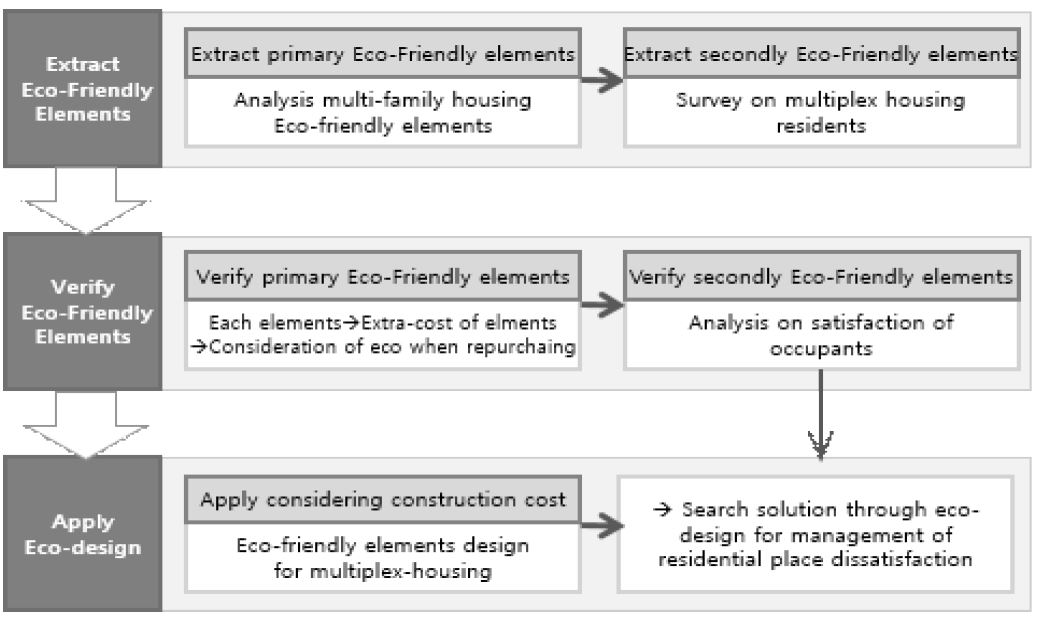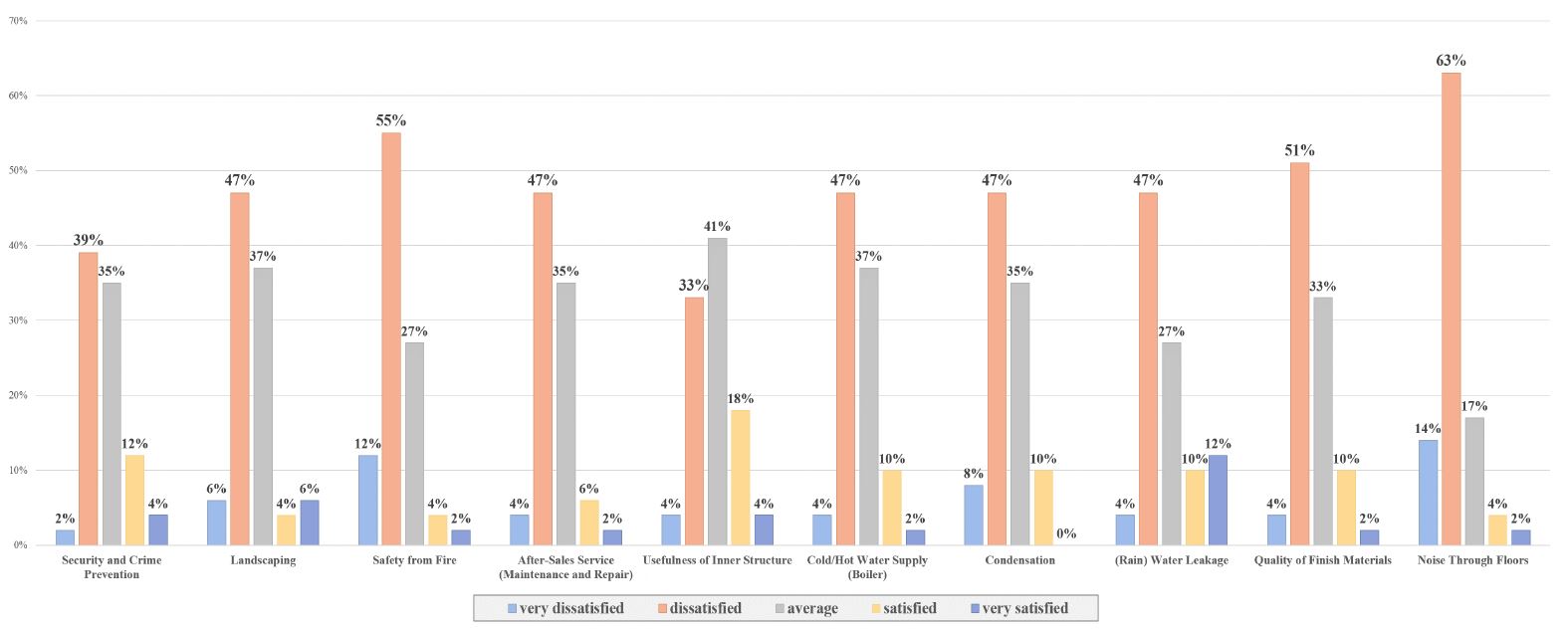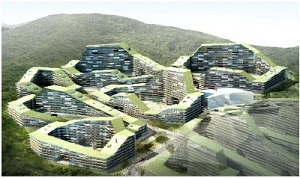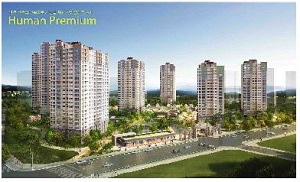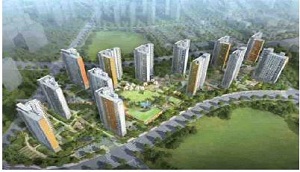
Green Building Design Strategies for Multiplex Housing
©Copyright Korea Institute of Ecological Architecture and Environment
Abstract
Energy saving in the built facilities is getting important due to energy crisis. The Korea government has been implemented several energy and green building policies and practices. The both of government and industry also developed green building strategies ant technologies to reduce energy consumption and carbon emission. The purpose of this research is to identify applicable green building strategies and technologies for that can be cost effective and applicable to a multiplex house.
This research identified appropriate green building strategies from analysing green building strategies from G-SEED certified apartment projects and popular green building strategies. This study also adopted a survey research method to find out the applicable green building strategies for a multiplex housing. In addition, this research also conduct cost estimating to identify initial cost premium of green building strategies.
The research outcomes in this study guide a building owner to know about initial cost premiums of green building strategies and technologies and an architect and contractor to identify appropriate and cost effective green building strategies that can be applicable to a multiplex house.
Keywords:
Green building, Green building strategies, Multiplex housing, Cost saving1. Introduction
1.1. Research Background and Purpose
As attention is drawn to the quality of meaningful life and voices are raised over the importance of environment, so-called ‘Environmental Sound and Sustainable Development (ESSD)’ has become talks of the town all over the world. Under the influence, environment-friendly building has emerged as a new paradigm in housing industry.
As for South Korea, land and housing development have been implemented with less care, so the urban environment has deteriorated. As a result, the people criticize it and want to improve life quality. In response, the concept ‘sustainable development’ has been strongly introduced into construction fields to minimize the impact of development on environment. Over the last 30 or 40 years, urban development has been driven by economic logic, disregarding the importance of environment. As a result, the quality of natural environment degraded and it has accompanied many issues such as air and water pollution, reduction of green land, serious traffic congestion, and consequential law suits, which surpassed the margin of environmental capacity. It seems hard to live a healthy urban life now. The main reason why the urban environment has reached such poor state is that environmental affinity was not reflected in the design elements from design stage.1) Now, environment-friendly architecture is gradually shifting from introduction stage to a stage of application to reality. For example, some of recent housing complexes are introducing environment-friendly elements to building to differentiate themselves from others, emphasizing their qualitative superiority. However, most of environment-friendly concepts applied to those residential complexes are based on facility-led environment advancement techniques, which are characterized with expensive materials and high specifications, but they is reluctant to introduce ‘passive design system’. In other words, it is burdensome and unrealistic to introduce such expensive and high-quality facility system to multiplex housing, where common residents will reside, in terms of business and economic feasibility. In general, a building owner is someone who hasn’t received proper education on architecture, but had hand-on experiences in construction site and has tendency to construct buildings only based on profitability. Of course, building multiplex housing on business feasibility and profitability is not against law. However, it is worth considering it problematic to approach architecture with simply economic logics, without giving enough thoughts to residents’ comfort and convenience from the perspective of architectural stainability and the idea that it is a part of human life. Furthermore, it seems that architects also need to have interest in environment-friendly housing complex and make voluntary effort to induce building owners to the way through maintaining reasonable construction cost and improving business feasibility from design stage.
In this respect, the present study is aimed to provide the basic data necessary to spread pleasant housing to the public, not to specific users or segments, by taking a realistic approach for those who actually need housing; considering the application of environment-friendly design elements; maintaining reasonable cost of construction through improving an existing floor plan; and applying environment-friendly elements to multiplex housing, which is excluded from the design stage of green building.
1.2. Research Scope and Method
As research method, this study review previous literature related to the characteristics of environment-friendly architecture and environment-friendly elements applied to multiplex housing to find out how those elements are applied to a house. In addition, based on literature review, this study finds out the environment-friendly elements that are applicable to multiplex housing and conduct a survey to examine how multiplex housing residents are aware of the importance of environment-friendly elements by item, and suggests a plan to apply the selected elements to multiplex housing and improve them.
Because green building design techniques applied to apartment building mainly consist of expensive specifications and high-quality facility, it is difficult to apply them to multiplex housing in fact, which is categorized as small housing. In this respect, this study attempts to review precedent researches on the environment-friendly elements of a building and apartment building; derive environment-friendly design elements from them; and find a way to apply the selected elements to green building design for multiplex housing.
2. Literature Review and Theoretical Background
Some studies researched green building certification system and environment-friendly planing: ‘A study on the improvement of the green building certification system in Korea’ (Suh Hyeong-ju, 2012); ‘A study on the Improvement of the Green Building Certification System’ (Lee Tae-gyeong, 2013); ‘A study on the Improvement of the Green Building Certification System’ (Kim Tae-beom, 2009); ‘Research on the eco-friendly planning elements in multi-house outdoor space’ (Cho, Hoon-Hee, 2011)’ and there are other studies concerning the current status and improvement of certification system and methods to improve apartment building through the analysis of environment-friendly design elements . In addition, there are studies looking into the application of renewable energy: ‘Development and application of a simulation program to optimize renewable energy for sustainable buildings’ (Kim Jong-heon, 2010)’ and ‘A Study on the Potential of New & Renewable Energy and Characteristics of Regional Natural Resources in Korea’ (Jung Dong-jin, 2011).
Originally, environment-friendly design has been much studied in America and Europe, and Korea is well implementing Korean green building certification system as well as taking a wise advantage of the ‘green building’ regulations and standards of advanced countries. Especially, ‘Green Building Certification System’, which is important for environment-friendly construction, has passed the stage of introduction, during which green buildings were hardly built, and started to prevail in construction industry from 2006. Table1 shows the current status of buildings that acquired green building certification from 2002 to 2015 (‘Green Building Rating Certification Lists’, Ministry of Land, Infrastructure and Transport).
As for ‘Green Building Certification’, most of the cases (that acquire the certificate) are found in ‘apartment building’ but rarely among multiplex housing, which are classified to small house by the standard of green building certification system. Therefore, this study analyzes green building design and items of certification system for apartment building; green building design techniques; and environment-friendly elements, which have been much studied, for starter, and then focus on the extraction of environment-friendly design elements that are applicable to multiplex housing and their applicability, which are the subjects that need further research.
3. The First Green Building Strategies for Multiplex Housing through Case Studies
As mentioned in Table 1, currently, there are few cases where environment-friendly design elements have been appled to multiplex housing, so it is not easy to analyze it. Therefore, this study chooses as research subject some cases of the representative apartment buildings, which were applied with green building design, and analyze them to find out common design elements among them. And then this study extracts the 1st environment-friendly design elements from them for multiplex housing.
3.1 Summary of Target Apartment Buildings
3 buildings, which have been recently constructed, were chosen among domestic buildings and the design elements applied to them were analyzed. The results are shown in Table 5.
The results show they basically use the same environment-friendly design elements but some of applied architectural techniques, some elements subject to site conditions, and renewable energy (application/non-application). Looking them more in detail, 5 items of ‘land use and transport’ and 8 items of ‘energy & environmental pollution’ are commonly used. In total, 17 of 36 items are commonly used to the target buildings.
Particularly, among 8 items of ‘energy & environmental pollution’, passive system such as ‘retrenchment of energy through insulation performance improvement’ and ‘windows system with high levels of insulation and airtight’ is thought to be essential elements for multiplex housing as energy reduction strategy.
In sum, this study first extracted the environment-friendly design elements that are commonly applied to the target apartment buildings and analyzed them to reconsider applying those elements to multiplex housing. For example, ‘biotope construction’ for landscape was considered less realistic for multiplex housing because of narrow site, so this study changed its purpose to kitchen garden. These considerations are summarized in Table 6.
4. Survey-Based Extraction of Environment-Friendly Design Elements for Multiplex Housing
4.1 Outline of Survey
Upon primary environment-friendly design elements, which were found by analyzing 3 cases (apartment buildings), a survey was conducted on residents in multiplex housing to extract the elements they think actually necessary. The questionnaire is composed of like in Table 7. The importance of green building design elements was measured on 5-point Likert scale.
4.2 Survey Scope and Method
Gwangju-si (Gyeonggi-do Province), where multiplex housing projects of about 14,000 households were approved from 2011 to 2015, was selected as research area because it is most notorious for unplanned development in the nation. In detail, the survey was carried out on 158 households in multiplex housing complexes (approved of use after 2012) in Gwangju-si, Gyeonggi-do Province. Questionnaires were distributed via postal mail in October, 2015 and 51 questionnaires were collected (collection rate is 32%). Mainly, the surveyees were asked to evaluate the primary design elements and their satisfaction with the current residence. This effort was aimed to empirically extract environment-friendly design elements they need. The collected data were analyzed for these analyses. First, frequency analysis was conducted to know the general characteristics of the respondents. Second, One way Anova (t-test for difference between means) was carried out to find difference by the characteristic. Third, correlation analysis was implemented to see the relationship between the general factors and evaluation items. All the empirical analyses of this study abided by coincidence level of p<.05. For statistical process, SPSSWIN 21.0 program was used.
3.1. 4.3 Basic Statistics of Participants
Demographic characteristics of the survey participants are as follows: (sex) males (68.6%) and females (31.4%). More males participated in the survey; (age) 30s (60.8%). relatively young people more participated in the survey; (marital status) married (68.6%); (co-habitation) independent household from parent(s) (25.5%); (educational achievement) high school graduates (29.4%) and college graduates (47.1%); (occupation) technical post (33.3%); (monthly income) 2~4 million won (64.7%). Combining those facts, it is known that multiplex housing is more preferred by newly married couples who achieved middle or low education, belong to middle or low income brackets and so financially not stable yet.
Almost majority of the respondents (49%) chose multiplex housing for reasonable house price for size (Pyung), which is followed by ‘for good scenery and environmental pleasantness (20%)’. In addition, 74% of them expressed negative answers to the question ‘application of environment-friendly design elements’. Their ratio of own equity to house price turned out low, 20-30%. It indicates that they make a house purchase decision on income level rather than preference. Therefore, they have a negative awareness of environment-friendly elements in realty and choose multiplex housing as realistic alternative.
Because 70.59% of the respondents replied ‘agree’ on ‘considerate on repurchase multi-house’ if given economic opportunity, it indicates they also want pleasant living environment. But they also will give up the pleasantness unless economic conditions are not in favor of themselves.
4.4 Final Extraction of Environment-Friendly Design Elements for Multiplex Housing from Importance Analysis
Table 10 shows green building design elements the residents in multiplex housing think important.
‘Retrenchment of energy through insulation performance improvement’(4.80) was the design element that the residents think of as most important and ‘construction forming soundproofing floor’, ‘natural ventilation system’, ‘temperature control system by room’, and ‘reduction water fee through water-saving facilities’ were also important design elements. Therefore, it was confirmed that the respondents think of ‘indoor environment’ elements as most important. Besides, ‘use of eco-friendly materials’, ‘minimizes thermal losses through high levels of insulation and airtight windows systems’, ‘reduction gas cost through high efficiency heating system’, ‘planning considered daylight’, and ‘eco-friendly long-life LED lights’ were also highly evaluated (over 4.0) in importance. With the elements that they evaluated over 4.0 (‘important’) on Likert scale, this study extracted the final green-building design elements for multiplex housing. The results are expressed in Table 11.
5. Verification of Exacted Green Building Design Elements
5.1 Correlation Analysis: General Factors and Surveyed Items
Correlation analysis was carried out the relationship between the general factors (ratio of own equity to house selling price, additional expenditure on environment-friendly design elements, consideration over environment-friendly characteristics, which the participants answered in the questionnaire) and evaluation items.
Correlation between ‘land use and transport’ and general factors turned out as follows: ‘land use and transport’ and ‘ratio of own equity to house selling price’ (negatively correlated at r=-.253); ‘considering transport accessibility’ and ‘expenditure on eco-friendly elements’ (positively correlated at r=.239); ‘construct bicycle depository’ and ‘expenditure on eco-friendly elements’ (positively correlated at r=.236), which are not statically signifiant at p<.05. Therefore, it indicates that the respondents are less interested in ‘land use and transport’ when their ‘ratio of own equity to house selling price’ is higher.
Correlation between ‘energy & environmental pollution’ and general factors turned out as follows: ‘ratio of own equity to house selling price’ is not significantly correlated with ‘energy & environmental pollution’. However, ‘expenditure on eco-friendly elements’ has a statistically significant correlation with ‘7. minimizes thermal losses through high levels of insulation and airtight windows system (r=.283(pp<.05))’, ‘8.switch for all lights (r=.428(p<.01)), and ‘10. device for standby power cut-off (r=.428(pp<.01))’, respectively.
In addition, ‘consideration for eco-friendly when repurchasing multi-housing’ also has a statistically significant correlation with ‘8.switch for all lights (r=.428(p<.01))’, ‘9. Eco-friendly long-life LED lights (r=.425(p<.01))’, ‘10. device for standby power cut-off (r=.425(p<.01)’, ‘11. reduction energy through new&renewable energy (r=.338(p<.05))’. Overall, ‘expenditure on eco-friendly elements’ and ‘consideration for eco-friendly when repurchasing multi-housing’ are significantly correlated with ‘energy & environmental pollution’, which indicates that if given economic opportunity, they want pleasant living environment.
Correlation between ‘material and resources’ and general factors turned out as follows: ‘ratio of own equity to house selling price’ and ‘use of eco-friendly/certified materials’ (significantly positively correlated); ‘expenditure on eco-friendly elements’ and ‘use of eco-friendly/certified materials’ (not significantly correlated); ‘consideration for eco-friendly when repurchasing multi-housing’ and ‘use of eco-friendly/certified materials’ (significantly positively correlated at r=.484, p<.001). These results indicate that the participants are less interested in ‘use of eco-friendly/certified materials’ when they have higher ‘ratio of own equity to house selling price’. On the other hand, it was found that they want to use eco-friendly materials when re-purchasing multiplex housing and have intention to pay additional expense for it.
Correlation between ‘hydrological cycle management’ and general factors turned out as follows: ‘ratio of own equity to house selling price’ and ‘expenditure on eco-friendly elements’ are not significantly correlated with ‘13. reduction water fee through water-saving facilities’. ‘consideration for eco-friendly when repurchasing multi-housing’ and ‘13.reduction water fee through water-saving facilities’ (significantly positively correlated at r=457, p<.001). These results indicate that the participants are less interested in ‘reduction water fee through water-saving facilities’ when they have higher ‘ratio of own equity to house selling price’. On the other hand, it was found that they want to save water fee by using water-saving facilities when re-purchasing multiplex housing and have intention to pay additional expense for it.
Correlation between ‘indoor environment’ and general factors turned out as follows: ratio of own equity to house selling price and ‘expenditure on eco-friendly elements’ are not significantly correlated with ‘indoor environment’. ‘Consideration for eco-friendly when repurchasing multi-housing’ and ‘temperature control system by room’ (significantly positively correlated at r=.281, p<.01). These results indicate that the participants are less interested in ‘indoor environment’ when they have higher ‘ratio of own equity to house selling price’. On the other hand, it was found that they want ‘temperature control system by room’ and ‘construction forming soundproofing floor’ when re-purchasing multiplex housing and have intention to pay additional expense for it.
5.2 Satisfaction with Current Management of Residence
The overall satisfaction with living in multiplex housing turned out lower than the average. Particularly, the respondents expressed strong dissatisfaction with noise through floors and after-sale service (including maintenance and repair). This is the product of profitability-based construction rather than orienting for residents’ pleasantness and convenience. However, most of the items answered natively seem to be pleased with the application of environment-friendly design elements. Therefore, this study estimated the cost of environment-friendly design elements to be 5 million to 10 million KRW. The base for this additional expenditure is on the amount the survey participants’ intention to spend on green building design elements.
The satisfaction survey shows that the participants are satisfied with security and crime prevention of their multiplex housing (43%) and dissatisfied (39%). These figures indicate they may feel unsafe. Therefore, it is necessary to secure safety by installing CCTV and covers for gas pipes.
The satisfaction survey shows that the participants are satisfied with landscape facility of their multiplex housing (43%) and dissatisfied (39%). These figures indicate that there is no landscaping facility or it is inefficient. Therefore, it is necessary to build kitchen garden and scenic planting in the space where there is no such interference as parking or vehicle commuting.
The satisfaction survey shows that the participants are very dissatisfied with safety from fire (47%). In case of apartment housing, it is often located in urban areas between wide roads, so fire engines can get easy access to the areas. However, most of multiplex housing is built in non-urban areas with narrow roads (less than 6 meters in width), so it is difficult for fire trucks to get access through them. Therefore, it is necessary to improve safety from fire for multiplex housing. Possible solution can be to use anti-flammable environment-friendly materials to prevent fire velocity.
The satisfaction survey shows that the participants are satisfied with after-sales service (maintenance and repair) of their multiplex housing (35%) and dissatisfied (47%). In case of apartment housing, after-sales service (maintenance and repair) is handled through its management office. For multiplex housing, however, its residents have to deal with it for themselves. They are experts, so they have hard time doing after-sales service work. A possible solution is to provide them a manual for maintenance and repair, though partially helpful.
The satisfaction survey shows that the participants are satisfied with usefulness of inner structure of their multiplex housing (47%), which is higher than other items in general. It indicates that this satisfactory result is from the floor plan of multiplex housing, which is much reproduced from that of apartment housing.
The satisfaction survey shows that the participants are satisfied with cold/hot water supply (boiler) of their multiplex housing (37%) and dissatisfied (47%). It was found through the survey that most of the boilers installed in multiplex housing are low-efficient boilers (Energy Efficiency Labeling: 4 Class ). Therefore, it is necessary to replace them with boilers of Class 1.
The satisfaction survey shows that the participants are satisfied with condensation of their multiplex housing (35%) and dissatisfied (47%). These figures indicate that multiplex housing is vulnerable to thermal bridge break due to inside insulation. A possible solution is to replace it with outside insulation. The following points are what deserves attention during for construction supervision.
- ⦁ Gap treatment (sealing, filling) on the joints of insulators to prevent thermal bridge break
- - Filling the gap of insulators (urethane form) + taping
- ⦁ Sealing work to minimize inflow of paste during concrete placement
- ⦁ Spacing work to prevent insulators from damage during follow-up construction (e.g. steel work)
- ⦁ Using inserts for insulators to prevent insulators from attaching work
The satisfaction survey shows that the participants are very dissatisfied with (rain) water leakage (47%). The main cause for water leakage is poor construction. The following points are what deserves attention during for construction supervision.
- ⦁ Checking that water content of concrete is below 6% during liquid-applied membrane waterproofing work
- ⦁ Waterproofing work needs to be done sequentially and for the shortest period of time, considering drying status
- ⦁ The thickness of paint filming needs checking (one specimen needs collecting, checking and storing)
- ⦁ Over-coating work in case the thickness of paint filming fails to meet requirements
The satisfaction survey shows that the participants are satisfied with the quality of finish materials of their multiplex housing (33%) and dissatisfied (51%). These figures indicate that it is necessary to use environment-friendly and certified finish materials that do not release environmentally hazardous chemicals and thus improve their satisfaction with the quality of finish materials.
The satisfaction survey shows that the participants are very dissatisfied with noise through floors (63%). Currently, complaints of noise through floors have been a hot social issue in apartment building. According to National Environmental Dispute Resolution Commission, complaints of noise through floors is the most cases as of 2015.
To tackle this problem, therefore, it is necessary to improve the soundproof capacity of walls and floors by replacing existing T20 floor impact sound buffer with T60 floor impact sound buffer.
5.3 Application of Green Building Design Elements to Multiplex Housing
The priority order of environment-friendly design elements for multiplex housing is based on the results from the importance awareness survey.
Table 17 shows the breakdown of additional cost for applying green building design elements to multiplex housing (based on one house unit of multiplex housing in Gwangju-si, Gyeonggi-do Province: floor space of 59m2; selling price of 150 million KRW). The figures in the table are based on the data of ‘2015 Breakdown Cost Table’ of ‘Nakwon Construction Co.’ that specializes in the construction of multiplex housing and the data from its partners.
6. Conclusion
The present study began from the perspective that low-income class is also the members of our society and should deserve ‘contemporary built environment’. In this respect, this study attempted to find a way to apply environment-friendly design elements to multiplex housing to the effect of social equilibrium. That is, considering the application of green building design elements to multiplex housing, which has been isolated from th mainstream of the society, this study tried to find a plan to apply pleasant residential building to the mass public and provide the basic data for realizing the objective, which are the significance of this study. The findings from this study are as follows.
First, common green building design elements of apartment building were analyzed by case studies (3 target buildings). Based on it, a questionnaire was designed for the residents of multiplex housing.
Second, almost majority of the respondents (49%) chose multiplex housing for reasonable house price for size (Pyung). In addition, 74% of them expressed negative answers to the question ‘application of environment-friendly design elements’. It means they make a house purchase decision on income level rather than preference. Therefore, they have a negative awareness of environment-friendly elements in realty and choose multiplex housing as realistic alternative. But 70.59% of the respondents replied ‘agree’ on ‘considerate on repurchase multi-house’ if given economic opportunity. It indicates they also want pleasant living environment. But they also will give up the pleasantness unless economic conditions are not in favor of themselves. Third, with the items of the questionnaire on environment-friendly design elements, this study analyzed ‘2015 Breakdown Cost Table’ of ‘Nakwon Construction Co.’ that specializes in the construction of multiplex housing and the data from its partners to know how much additional cost increased when the green building design elements are applied to multiplex housing. The analysis found that about 6,558,000 KRW (Korea Won) increased. With this data, this study asked ‘Nakwon Construction Co.’, ‘Gaga Construction Co.’, ‘Good Day Vil Housing Sales Team’ , and ‘Creance Housing Sales Team’, which specialize in construction and sales of multiplex housing in Gwangju-si, Gyeonggi-do Province if it is possible to apply environment-friendly design elements to multiplex housing as designed with the additional expense mentioned above. They responded it was possible. Therefore, it was known that applying those design elements, which are extracted and selected for multiplex housing, can not only provide residents pleasant living environment, but also offer a building ower an opportunity to differentiate the building from its neighboring structures with elevated brand image. When they were asked for their intention to apply them, they responded positively.
By conducting a survey with questionnaires on the residents in multiplex housing, the present study examined their satisfaction/dissatisfaction with residence and tapped the applicability of green building design elements and improvements. The findings of this study can be used as the basic data in applying the design elements to multiplex housing. However, this study has limitations that the research subjects were multiplex housing which is constructed on individual lots of land. Therefore, the findings can not be generalized to complex-style multiplex housing which is similar to apartment building. Therefore, additional research is needed on complex-style multiplex housing.
Acknowledgments
This research was supported by a grant (11 High-tech Urban G03) from the High-tech Urban Development Program funded by the Korean Ministry of Land, Infrastructure and Transport.
Notes
References
- Kim, Young-Ran, Application of Seoul eco-friendly development, Proceedings of Seoul Development Institute, (2001).
- MOLIT, Green Building Rating Certification Lists, (2015, September).
- Seo, Hyung-Joo, A study on the improvement of the green building certification system in Korea, Proceeding of the Seoul National University Environmental graduate school, (2012).
- Lee, Tae-Kyung, A study on the Improvement of the Green Building Certification System, (2013).
- Kim, Tae-Beom, Research on the factors for planning eco-friendly group houses, (2009).
- Cho, Hoon-Hee, Research on the eco-friendly planning elements in multi-house outdoor space, (2011).
- Kim, Jong-Heun, Development and application of a simulation program to optimize renewable energy for sustainable buildings, (2010).
- Jung, Dong-Jin, A Study on the Potential of New & Renewable Energy and Caracteristics of Regional Natural Resources in Korea, (2011).
